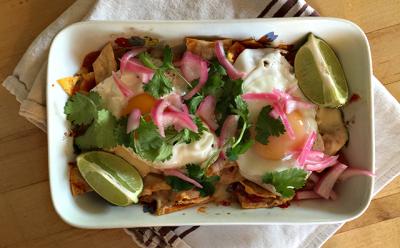Seasons by the Sea: Most Important Meal of the Day

Breakfast. It’s the most important meal of the day. Or is it?! You can read studies supporting this theory, and you can find research that refutes it. It definitely makes sense for children.
It has been scientifically proven that if you eat a balanced, nutritious breakfast, you are more likely to eat a nutritious lunch and dinner and less likely to eat junky snacks. It doesn’t have to be time consuming either; you can grab an apple or a banana and a yogurt, and that counts. It has also been proven that when children eat a good breakfast, they have more energy and focus throughout the morning.
Growing up in the ’50s and ’60s I recall our mother making freshly squeezed orange juice for us every morning. How lucky were we? Unfortunately, we’d also have a big glass of milk with breakfast, and I would balk until the end of the meal and have to drink both in quick succession before bolting for the school bus or carpool. If you’ve ever tasted this combination you know how gross it is. Some days we had oatmeal or Cream of Wheat, sometimes dry cereal with fruit, and on weekends it would be eggs or pancakes. Pretty healthy, right? But chances are our father was at the table smoking his Kent cigarettes, and then we’d pile into the ’64 convertible Mustang and barrel down the George Washington parkway with no seat belts. Ahhhh, the good old days!
If you’ve ever had the opportunity to experience breakfast traditions in other parts of the world, you were probably amazed at how different they are. In many countries of Europe, they basically eat cold cuts and cheese in the morning. The French enjoy a flaky croissant with coffee. A common breakfast in Asia is congee, a watery rice gruel that can be topped with anything from steamed fish to fried garlic and scallions, pickled vegetables, and spicy condiments. In Thailand, fried rice is offered.
One of my favorite, very naughty morning meals is a full Irish (or English) breakfast. This traditionally consists of many kinds of meats: bacon, sausage, and two types of pudding, black and white, baked beans, sauteed mushrooms, broiled tomato halves, eggs, brown bread with butter and marmalade, and lots of tea. Black pudding is made from blood, meat, fat, and oatmeal or bread fillers. White pudding is the same without the blood. Needless to say, those hearty breakfasts are meant for people who are about to spend all day working on a farm or at other forms of hard labor.
Breakfasts in India vary greatly from region to region but often include dosas, idli, uttapam, or rotis served with a variety of chutneys, cilantro, coconut, tamarind, and more. The batter for dosas and idli are healthy and light, made with chickpea or rice flour.
Another of my favorite breakfasts is chilaquiles, popular in Mexico. You can make a huge batch in a cast iron skillet, pop it in the oven, and cut it into wedges for serving. It is essentially fried tortillas with fresh salsa, topped with cheese, fried eggs, sometimes radishes, cilantro, pickled onions or scallions, a bit of crema, and lime wedges.
In Jamaica, ackee is a common breakfast offering. Ackee is the national fruit and national dish of Jamaica. The fruit comes from an evergreen tree and must be fully ripe before cooking. It is often sold canned as well. The ackee is cooked with saltfish (salted preserved cod), onions, peppers, and spices and served with fried plantains.
Where did our ubiquitous breakfast cereals come from and how did they become so popular? In 1866, a group of Seventh Day Adventists set up a water cure colony in Battle Creek, Michigan, called the Western Health Reform Institute. The diet was vegetarian, grain-based, and generally monotonous. One of the Adventists, Harvey Kellogg, went to New York to study medicine and was living in a boarding house with no cooking facilities. He experimented with a cereal that didn’t need cooking; it was a mixture of wheat, oats, and corn, formed into a biscuit and ground up. He named it Granula, Latin for “little grain.” There was already a product with this name so he changed it to “granola.”
In 1893, a lawyer in Denver named H.D. Perky invented Shredded Wheat. When Kellogg got wind of this, he went to meet Perky and offered him $100,000 for the patent. At the last minute Kellogg withdrew his offer but had learned so much from Perky he was able to go home and come up with a similar cereal, called Granose.
Charles W. Post was an inventor who had been a patient at the Battle Creek sanitarium. Along with a fireless cooker, a water-powered electric generator, and an early version of the postal order called Post Currency Check, he invented Postum (a grain-based coffee substitute) and Grape Nuts cereal.
By 1908, everyone was making gobs of money from a product that had cheap ingredients and a high price. Quaker Oats Company came along and jumped on the cornflake bandwagon, and now we have a ridiculously huge number of (mostly unhealthy) breakfast cereals, 387 as of 2009. A product that was created with the best of intentions has turned into Count Chocula, Cap’n Crunch, and “Yucky” Charms.
You are an adult so you can choose whether or not to eat breakfast, but it truly is important that you get your children to eat a nutritious breakfast before school. Make some morning glory muffins and freeze them, make some homemade granola if they’ll eat that. Boil an egg, toast some whole grain bread, it doesn’t take long, but the benefits will last a lifetime. Or at least until lunch.
Click for recipes
